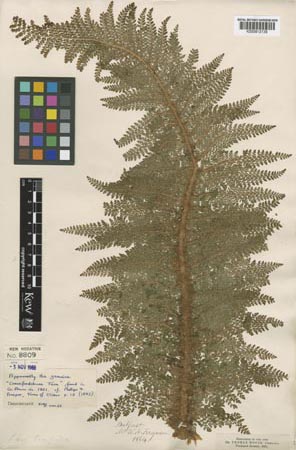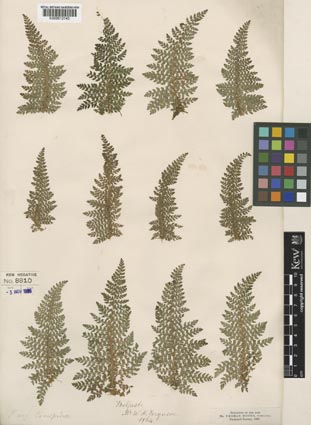Polystichum setiferum 'Divisilobum Crawfordiae'
The Crawfordsburn Fern
A single plant of the Crawfordsburn fern was discovered by a labourer of Mrs Crawford in what was known as Mrs Crawford’s Garden, a 5748 acre estate that is now the Crawfordsburn Country Park. It was found in 1861 at the height of the Victorian fern craze and we may presume that the original plant was removed from its natural habitat. We know that fronds were collected in 1864 by Mr. W. H. Ferguson, the director of Belfast Botanic Gardens, so the Friends of Belfast Botanic Gardens have a vested interest in this fern and its story. Fronds from his collection were sent to Kew where they still exist in the Kew Herbarium (see fig 1 and 2). After the 1860s the story gets increasingly vague. We would love to know if Ferguson propagated the fern in the Botanic Gardens, but have no evidence to support this. Neither do we know if he sent living specimens to other botanic gardens or if other specimens were collected in the wild and recorded or preserved.


The fern is described in The Ferns of Ulster by W. H. Phillips and R. Ll. Praeger 1887, as is quoted in both Stewart and Corry 1992 and in Charles Nelson’s ‘A Heritage of Beauty’, 2001 as follows:
“[Polystichum] divisilobum Crawfordiae. (proliferum Crawfordianum of Stantfield), Crawfordsburn, Co. Down, Miss Crawford. This is the celebrated Crawfordsburn fern, one of the most beautiful of a beautiful class, which was found near Crawfordsburn in 1861 by a labourer of Miss Crawford, only a single plant being discovered at the time, and in spite of frequent search it has never been found since. The plants usually sold as Crawfordsburn Ferns in the market are a far commoner form, viz, divisilobum Alchinii. The genuine plant is found in very few collections; it is easily recognised by the very broad and overlapping character of the pinnae, and the extreme breadth of the fronds.”
The recent discovery of plants alleged to be the Crawfordsburn fern by, among others, Martin Richard (past president of the British Pteridological Society) has demonstrated the continuing interest in this attractive fern. We at Belfast Botanic Gardens are keen to hear from anyone with information. Here is a quotation from the Bulletin of the British Pteridological Society,Vol. 6, 2005 no 4:
“His [Martin Rickard’s] other special interest cultivar was the Crawfordsburn fern (P. setiferum ‘Crawfordiae’). First found wild in Northern Ireland in 1861, it has become shrouded in mystery and in the minds of many considered to be probably extinct. Staff at Glasnevin Botanic Garden in Dublin have searched gardens for it in the past without success. Many people claim to grow it but on inspection all plants turn out to be a standard form of ‘Divisilobum’. However, last year Martin met a Northern Irish gardener, Margaret Glynn, who said she had it and would send him a frond. This she did and he was immediately impressed by the likelihood that this was THE fern. With Jim Denison of Limerick, Martin visited Margaret’s garden, and is now convinced that this is truly the fern. Another grower nearby, Gary Dunlop, also has the plant (from Margaret) and Gary has passed a piece to Jim. So, after a century or so in the wilderness, the Crawfordsburn fern is alive and well in at least three gardens in Ireland”.


